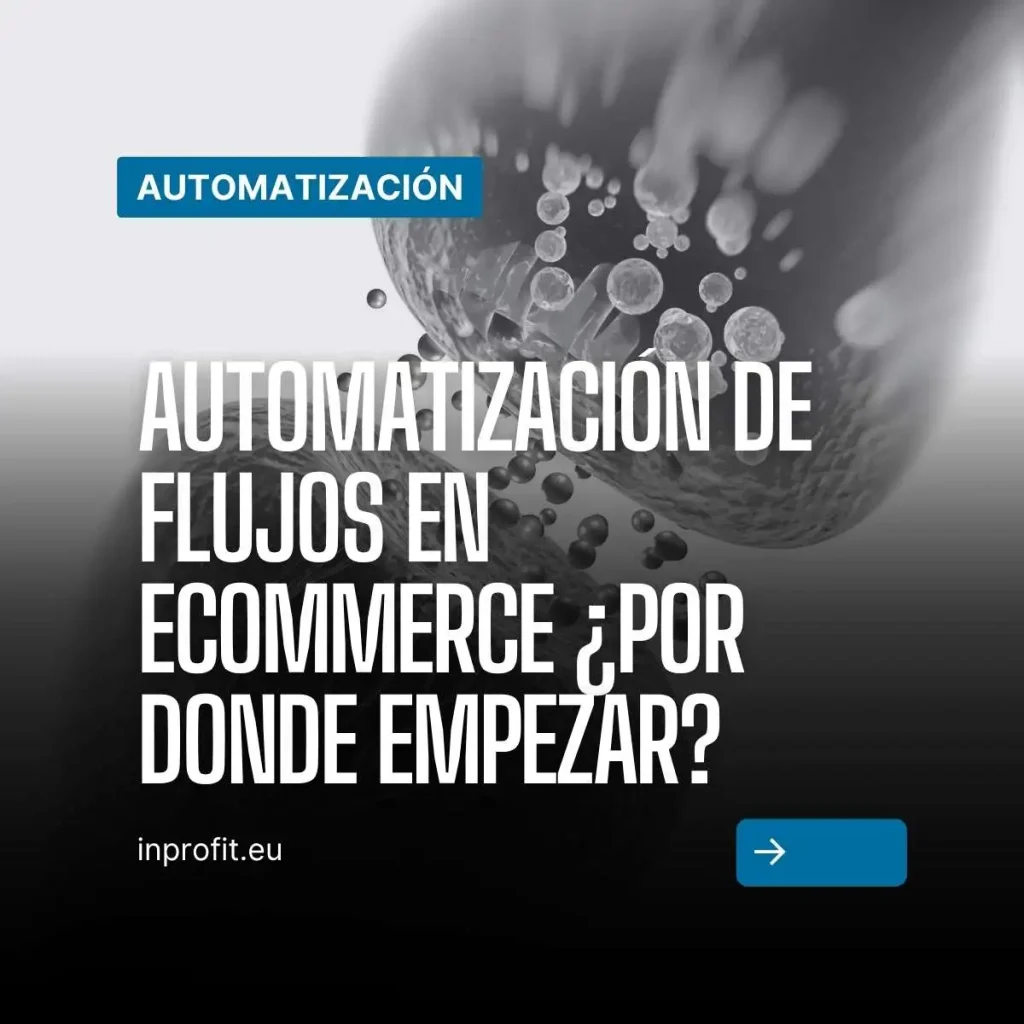From order management to personalized marketing, automation can transform an online business, saving time and resources while maximizing conversions. But where do you start? This article explores the basics of eCommerce automation, key flows to automate, recommended tools and a step-by-step plan to implement an effective strategy.
What is eCommerce flow automation?
The automation of eCommerce flows consists of using software and technology to execute repetitive tasks automatically, based on predefined rules or triggers. These flows connect different processes, such as processing orders, sending emails or updating inventory, so that they run smoothly without manual intervention. Benefits include:
- Time savings: Eliminates repetitive manual tasks, allowing the team to focus on strategy.
- Better customer experience: Fast, personalized responses improve satisfaction and loyalty.
- Error reduction: Automation minimizes human errors in tasks such as inventory management or invoicing.
- Scalability: Allows handling higher sales volumes without proportionally increasing resources.
- Actionable data: Automated flows generate data that can be analyzed to optimize strategies.
Key flows to automate in eCommerce
Antes de implementar la automatización, es importante identificar los procesos que más se beneficiarán. A continuación, se detallan los flujos más comunes y críticos en eCommerce:
Order management and fulfillment
- What to automate: Order processing, purchase confirmations, status updates and shipment notifications.
- Why: Reduces processing time and improves customer communication.
- Example: When a customer places an order, the system updates the inventory, generates an invoice automatically and sends a confirmation email with a tracking link.
2. E-mail marketing
- What to automate: Welcome emails, abandoned carts, product recommendations and personalized promotions.
- Why: Automated email marketing can increase conversions by 10-20%, according to Klaviyo studies.
- Example: A customer who abandons the cart receives an email 2 hours later with a 10% discount to encourage the purchase.
Inventory management
- What to automate: Stock updates, low stock alerts and synchronization with multiple channels (online store, marketplaces).
- Why: Avoids overselling and ensures a seamless experience across all channels.
- Example: When the inventory of a product drops below 10 units, an alert is sent to the purchasing team.
4. Customer Service
- What to automate: Answers to frequently asked questions, support ticket tracking and post-purchase surveys.
- Why: Improves customer satisfaction and reduces the burden on the support team.
- Example: A chatbot automatically answers questions about delivery times and then transfers complex cases to a human agent.
5. Personalization and segmentation
- What to automate: Product recommendations based on browsing history, behavioral customer segmentation and personalized campaigns.
- Why: Personalization increases conversion rates by offering relevant content.
- Example: A customer looking for running shoes receives similar product recommendations in a personalized email.
6. Management of returns and refunds
- What to automate: Processing return requests, generating shipping labels and issuing refunds.
- Why: Simplifies a process that can be tedious and improves customer confidence.
- Example: A customer requests a return via an online form, and the system automatically generates a shipping label and processes the refund upon receipt of the product.
Where to start: A step-by-step plan?
Implementar la automatización en eCommerce puede parecer abrumador, especialmente para pequeñas y medianas empresas. Este plan paso a paso te ayudará a priorizar y ejecutar una estrategia efectiva:
Step 1: Assess your needs and objectives
- What to do:
- Identify the most time-consuming or error-prone processes (e.g., manual order processing or mailing).
- Define clear objectives: increase conversions, reduce processing times or improve customer experience.
- Prioritize high-impact, low-complexity flows for fast results.
- Useful tools: Use Trello or Asana to map processes and identify bottlenecks.
Step 2: Select the right tools
- What to do:
- Choose an eCommerce platform that supports automation, such as Shopify, WooCommerce or Odoo.
- Integrates specific tools for each flow:
- Email marketing: Klaviyo, Mailchimp, HubSpot.
- Inventory management: TradeGecko, Zoho Inventory, Odoo.
- Customer support: Zendesk, Freshdesk, Intercom.
- General automation: Zapier, Make (Integromat), Automate.io.
- Make sure the tools are compatible and scalable.
- Example: A Shopify store can use Zapier to connect the platform with Mailchimp and send automatic emails after every purchase.
Step 3: Configure basic flows first
- What to do:
- Start with simple flows, such as order confirmation emails or low stock notifications.
- Use predefined templates in tools like Klaviyo or Shopify Flow to speed up setup.
- Test each flow with a small group of customers before implementing it on a large scale.
- Example: Set up a flow in Mailchimp that sends a welcome email to new subscribers with a 10% discount coupon.
Step 4: Integrate data and personalization
- What to do:
- Connect your eCommerce platform with a CRM (such as HubSpot or Salesforce) to centralize customer data.
- Uses behavioral data (pages visited, products in cart) to segment audiences and personalize messages.
- Implement action-based triggers, such as “abandoned cart” or “completed purchase”.
- Example: A customer who adds a product to the cart but does not complete the purchase receives a personalized email with the product and a limited offer.
Step 5: Monitor and optimize
- What to do:
- Set up dashboards in tools such as Google Analytics 4 or Looker Studio to measure key metrics (conversion rate, processing time, customer satisfaction).
- Perform A/B testing to optimize emails, messages or flows (e.g. test different email subjects).
- Gather customer feedback through automated surveys to identify areas for improvement.
- Example: If an abandoned cart email has a low open rate, try changing the subject line or the delivery time.
Step 6: Scale and expand
- What to do:
- Once the basic flows are working, add more complex automations, such as dynamic product recommendations or loyalty flows.
- Integrate additional channels, such as SMS or push notifications, for an omnichannel experience.
- Consider integration with marketplaces (Amazon, eBay) to synchronize inventories and orders.
- Example: Use Klaviyo to send personalized SMS with promotions to recurring customers, synchronized with the CRM.
Use Case: Automating Flows in an Online Coffee Shop with WordPress and WooCommerce
En el competitivo mundo del comercio electrónico, las tiendas online deben optimizar sus procesos para mejorar la experiencia del cliente, aumentar las conversiones y reducir la carga operativa. Este caso de uso describe cómo una tienda online de café artesanal, Café Aroma, utiliza WordPress y WooCommerce para implementar tres automatizaciones clave que optimizan sus operaciones, potencian el marketing y mejoran la satisfacción del cliente. A continuación, detallamos las tres automatizaciones, las herramientas utilizadas, los pasos de implementación y los resultados esperados.
Context: Café Aroma
Café Aroma is an online store that sells artisanal coffee of sustainable origin, with a catalog of beans, capsules and accessories for coffee preparation. Operating on WordPress with WooCommerce, the store faces challenges such as manual order management, lost sales due to abandoned carts and lack of personalization in customer communication. To address these issues, he implements three specific automations using WooCommerce-compatible plugins and tools.
Automation 1: Recovering Abandoned Carts with Personalized Mailings
Description
Many Café Aroma visitors add products to the cart but do not complete the purchase, which represents a loss of revenue. To recoup these sales, the store implements an automated email flow that encourages customers to complete their purchases.
Tool
- Plugin: AutomateWoo (a premium plugin for WooCommerce that allows you to create automated workflows).
- Add-on: WooCommerce to manage the cart and customer data.
Implementation
- Installation and configuration:
- Install and activate AutomateWoo from the WordPress plugin repository or the official website.
- Configure WooCommerce API credentials in WooCommerce > Settings > Advanced > API REST to allow AutomateWoo to access cart data.
- Creation of the flow:
- In the WordPress dashboard, go to AutomateWoo > Workflows > Add Workflow.
- Select the Abandoned Cart trigger and set a 2-hour delay after abandonment.
- Add a Send Email action:
- Subject : “Your favorite coffee is waiting for you! ☕”
- Content: Includes an image of the abandoned product, a personalized message with the customer’s name and a 10% discount coupon valid for 24 hours.
- Insert AutomateWoo dynamic variables (e.g. {{ customer.first_name }} and {{ cart.items > to customize the mailing.
- Set up a second follow-up email after 24 hours if the customer does not complete the purchase, with a more urgent message: “Last chance: complete your purchase with a 10% discount.”
- Tests:
- Simulates an abandoned cart by adding products and leaving the site without completing the purchase.
- Verify that the emails are sent correctly and that the links lead to the original cart.
- Regulatory compliance:
- Ensure that emails include an unsubscribe link, complying with regulations such as GDPR.
Expected Results
- 15% increase in abandoned cart recovery, according to AutomateWoo benchmarks.
- Improved customer experience through personalized messages.
- Increase of the average ticket due to the use of discount coupons.
Automation 2: Inventory Synchronization with Low Stock Notifications
Description
Café Aroma sells limited edition coffee beans, and overselling due to manual inventory management has created logistical problems. To avoid this, it implements automation that synchronizes inventory and sends automatic notifications to the team when stock levels are low.
Tools
- Plugin: WooCommerce Stock Manager (to manage inventory) and Zapier (to connect WooCommerce with external notifications).
- Add-on: WooCommerce to track stock levels.
Implementation
- WooCommerce Stock Manager configuration:
- Install the WooCommerce Stock Manager plugin from the WordPress repository.
- In WooCommerce > Stock Manager, configure stock levels for each product (e.g. low stock alert at 10 units).
- Creation of the flow in Zapier:
- Register on Zapier and create a new Zap.
- Select WooCommerce as the trigger application and choose the Stock Quantity Changed event.
- Set the filter so that the flow is activated only when the stock falls below 10 units.
- Add a Send Email action (via Gmail or a mail provider) or Send Slack Message to notify the purchasing team.
- Example message: “Warning! Product {{ product.name }} has only {{ product.stock_quantity }} units in stock. Restock ASAP.”
- Optionally, connect Zapier with Google Sheets to record low stock products in a spreadsheet.
- Tests:
- Simulates a purchase that reduces the stock of a product below 10 units.
- Verify that the notification is sent to the correct email or Slack channel.
- Optimization:
- Configure a second action to automatically pause the sale of a product in the store when the stock reaches 0, using the WooCommerce API.
Expected Results
- 100% reduction in overselling due to real-time synchronization.
- Savings of 10 hours per week in manual inventory management.
- Improved replenishment planning through proactive notifications.
Automation 3: Customer Loyalty with Personalized Rewards
Description
Café Aroma wants to increase customer retention by offering personalized rewards to frequent buyers. It implements an automated flow that identifies repeat customers and sends them an email with a discount code after their third purchase.
Tools
- Plugin: AutomateWoo (to create loyalty flows) and WooCommerce Points and Rewards (optional, for a points system).
- Add-on: WooCommerce to track purchase history.
Implementation
- Initial configuration:
- Make sure AutomateWoo is installed and configured.
- Verify that WooCommerce is tracking customer purchases (enable the customer accounts option in WooCommerce > Settings > Accounts and Privacy).
- Creation of the flow:
- In AutomateWoo > Workflows > Add Workflow, select the Customer Order Count Reaches trigger.
- Set the trigger to activate when a customer reaches 3 completed purchases.
- Add a Send Email action:
- Subject: “Thank you for your loyalty, {{ customer.first_name }}! ☕”
- Content: “You’ve shopped with us 3 times, and we want to celebrate! Use code LOYALCOFFEE for 15% off your next purchase!”
- Generate a dynamic coupon in AutomateWoo with a unique code and a usage limit of 1 per customer.
- Optionally, add a secondary action to award reward points if you use WooCommerce Points and Rewards.
- Tests:
- Create a test customer and simulate three completed purchases.
- Verify that the email is sent with the correct discount code and that the coupon works in the store.
- Regulatory compliance:
- Includes a link to manage subscription preferences in the email, complying with GDPR.
Expected Results
- 20% increase in customer retention through personalized incentives.
- 10% increase in customer lifetime value (CLV) for recurring purchases.
- Improved brand perception by rewarding loyalty.
General technical configuration
Prerequisites
- WordPress and WooCommerce: Make sure you have the latest version of WordPress and WooCommerce installed for plugin compatibility.
- Reliable server: Use a hosting optimized for WooCommerce (such as SiteGround or WP Engine) to ensure fast performance.
- WooCommerce API: Enable the REST API in **W eCommerce Flow Automation: Where to Start?
In the fast-paced world of eCommerce, operational efficiency is key to staying competitive. Automating eCommerce workflows allows companies to streamline repetitive processes, improve customer experience and scale operations without proportionally increasing costs. From order management to personalized marketing, automation can transform an online business, saving time and resources while maximizing conversions.
But where do you start? This article explores the basics of eCommerce automation, key flows to automate, recommended tools and a step-by-step plan to implement an effective strategy.
Recommended tools for eCommerce automation
- Synsight HubSolution with custom developments for WordPress and Woocommerce automations.
- Shopify Flow: Ideal for Shopify stores, it allows you to create automated flows for inventory, marketing and orders.
- Klaviyo: Powerful for email marketing and personalization, with native integrations for Shopify, WooCommerce and Magento.
- Zapier: Connects hundreds of apps to automate tasks such as data synchronization or notifications.
- OdooOdoo: A comprehensive solution to manage inventory, CRM, marketing and sales on a single platform.
- Zendesk: Automate customer support with chatbots and ticket flows.
- ActiveCampaign: Combines email marketing and CRM with advanced automation for small and medium businesses.
Automating eCommerce flows is an essential strategy to optimize operations, improve customer experience and scale an online business.
Getting started requires identifying key processes, choosing the right tools and following a phased approach that prioritizes high-impact flows. From abandoned cart mailings to inventory management, automation enables stores to be more efficient and competitive in a dynamic marketplace.
To get started, assess your needs, test tools and set up basic flows that you can optimize over time.
With a well-executed strategy, automation will not only save time, but will also boost your sales and strengthen your relationship with your customers.
Take the first step today and transform your eCommerce with automated flows!




